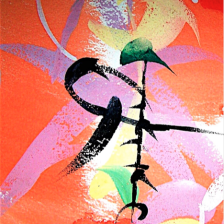
Etching and engraving, two colors offset from linoleum
16 x 20 in. Ed. 35 CR#109
photo: Indianapolis Museum of Art
Many classical paintings have been created around a biblical narrative known as the Massacre of the Innocents. Peterdi was familiar with it in works by Rubens, Cranach the Elder, Breugel the Elder, Tintoretto, and Ghirlandaio, to mention a few.
Peterdi’s MASSACRE OF THE INNOCENTS (1954) is his version—in modern dress. The context is WW II, with aerial bombardment.
As a U.S. soldier at the front, he had survived heavy artillery fire, had seen rotting corpses in battlefields, witnessed the liberation of a Nazi camp. He made drawings of it all, in real-time. Years afterward, he continued to process these images in his paintings and prints.
Ralph E. Shikes wrote,
The theme of Gabor Peterdi’s ‘The Massacre of the Innocents’ is as old as Christian art, the style as young as today, the effect, if studied, as shocking as that of Bruegel’s painting. Bombers attack. Tracer bullets make patterns in the sky. The earth is a shambles of horror, chaos abounds. It is a study in planes, lines, forms—and is a powerful comment. [The Indignant Eye; the Artist as Social Critic in Prints and Drawings from the Fifteenth Century to Picasso (Boston: Beacon Press 1969) p.394]
notes: the title refers to Herod the Great’s order to execute all male children the age of two years or less, in and around Bethlehem; Gospel of Matthew 2:16 [The New English Bible]
To see a partial list of well-known classical images on this theme, try http://www.textweek.com/art/massacre_of_innocents.htm.

